Animals
Discover Common Birds in Northern California
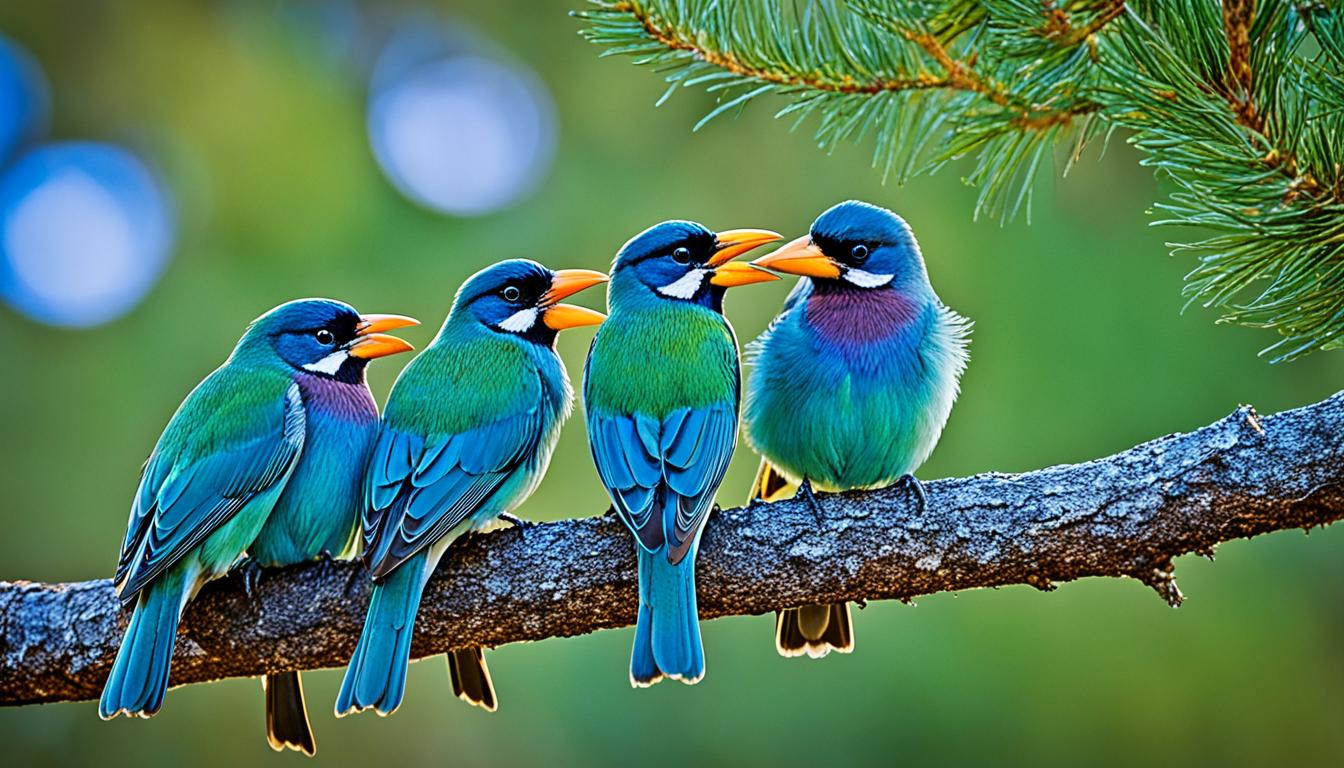
Did you realize that California hosts more than 684 bird species? From the rugged coastlines to the majestic mountains, Northern California is a paradise for birdwatchers and nature lovers. Thanks to its varied habitats and pleasant climate, this area welcomes a variety of common birds all year round. Whether you’re an experienced birder or a novice, discovering the avian marvels of Northern California is certain to bring joy and inspiration.
Key Takeaways:
- Northern California is home to over 684 bird species.
- The region’s diverse habitats attract a wide range of common birds.
- Birdwatching in Northern California offers unique opportunities to observe and appreciate nature.
- Understanding the characteristics and habitats of common bird species can enhance your birdwatching experience.
- Conservation efforts play a crucial role in protecting bird populations and their habitats in Northern California.
Dark-eyed Junco
Dark-eyed Juncos are one of the most abundant songbirds in North America. These small, charming birds are known for their striking appearances and fascinating winter behavior.
During wintertime, Dark-eyed Juncos become snowbirds, migrating from their breeding grounds in northern forests and mountain ranges to more southerly regions, including Southern and Central California. They prefer coniferous coastal and mountain habitats year-round in these areas. The arrival of Dark-eyed Juncos in winter signals the changing of seasons and adds a touch of magic to the landscapes they inhabit.
To identify Dark-eyed Juncos, look for their distinctive features. These birds have conical-shaped bills and round heads, with their dark eyes giving them their name. Their plumage varies depending on the subspecies, but generally, they have gray or brown upperparts and white bellies. Some individuals have pink or buff-colored flanks. The contrasting colors make them easily recognizable against the backdrop of snow-covered landscapes.
Dark-eyed Juncos are social birds and often forage in small groups on the ground, scratching for seeds and insects. They primarily feed on seeds and are regular visitors to bird feeders during the winter months. Offering a variety of seeds and suet can attract these delightful visitors to your backyard.
“The Dark-eyed Junco, with its beautiful plumage and winter migration, is a true marvel of nature. Observing these snowbirds in their natural habitats is a joy for bird enthusiasts and nature lovers.” – Bird Watchers Magazine
As winter residents, Dark-eyed Juncos bring life and vitality to California’s landscapes during the colder months. Their presence serves as a reminder of the intricate connections between birds and the changing seasons. Whether hopping on the ground or perching in trees, Dark-eyed Juncos are a delightful sight for both experienced birdwatchers and casual observers alike.
Allen’s Hummingbird
Allen’s Hummingbirds bring a burst of vibrant colors and joyful energy as they herald the arrival of spring in the coastal regions of California. These tiny birds make a long journey, spending their winters in Mexico and arriving in the shrubby habitats of California as early as January. Drawn by the abundance of flowers that bloom after the winter rains, Allen’s Hummingbirds add a touch of beauty to the coastal landscapes.
During the spring migration, Allen’s Hummingbirds engage in elaborate courtship displays, captivating onlookers with their acrobatic flight patterns and flashing reddish-orange throats. These displays are an enchanting sight to behold as the males show off their vibrant colors to attract mates.
To give you a glimpse of the mesmerizing Allen’s Hummingbird in action, take a look at the stunning image below:
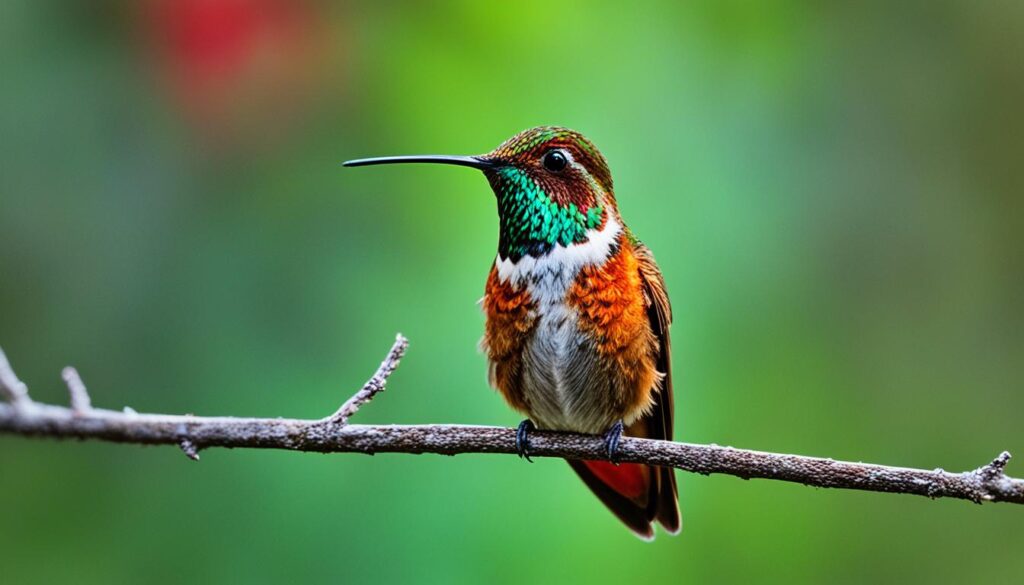
Explore the coastal regions of California during spring, and you may be lucky enough to witness these charming hummingbirds in their natural habitat. The Allen’s Hummingbird is truly a symbol of the changing seasons and the beauty of nature in the coastal regions of California.
California Towhee
The California Towhee, a sedentary bird exclusively found in California, is a common and easily recognizable species in the state. While there are a few exceptions in Oregon and the Baja Peninsula, these towhees are primarily residents of California’s diverse habitats. From wild chaparral hillsides to urban parks and gardens, they have adapted to various environments, thriving in both natural and human-altered landscapes. Their ability to adapt to urbanization has made them a familiar sight in towns and cities across the state.
California Towhees are known for their sedentary nature, rarely venturing far from their nesting areas. This behavior contributes to their abundant presence, as they establish territories and remain in the same vicinity throughout their lives. Their distinctive features, such as a rust-colored crown and a warm brown plumage, make them easily identifiable among other bird species.
These birds have a fascinating social structure, often forming monogamous pairs. They communicate through a variety of calls, including a melodic song that can be heard throughout the day. Additionally, California Towhees are ground foragers, hopping and scratching their way through leaf litter and underbrush in search of insects, seeds, and berries.
“The California Towhee is a delightful bird to observe, with its unique coloration and charming foraging behavior,” says renowned ornithologist Dr. James Peterson. “Their adaptability to urban environments is a testament to their resilience and ability to coexist with human settlements.”
To provide a comprehensive overview of California Towhees, here is a table highlighting their key characteristics:
| Species | California Towhee |
|---|---|
| Scientific Name | Melozone crissalis |
| Size | Approximately 8-9 inches in length |
| Plumage | Warm brown overall with a rust-colored crown |
| Habitat | Chaparral, scrublands, parks, gardens |
| Diet | Insects, seeds, berries |
| Behavior | Sedentary, ground forager, monogamous pairs |
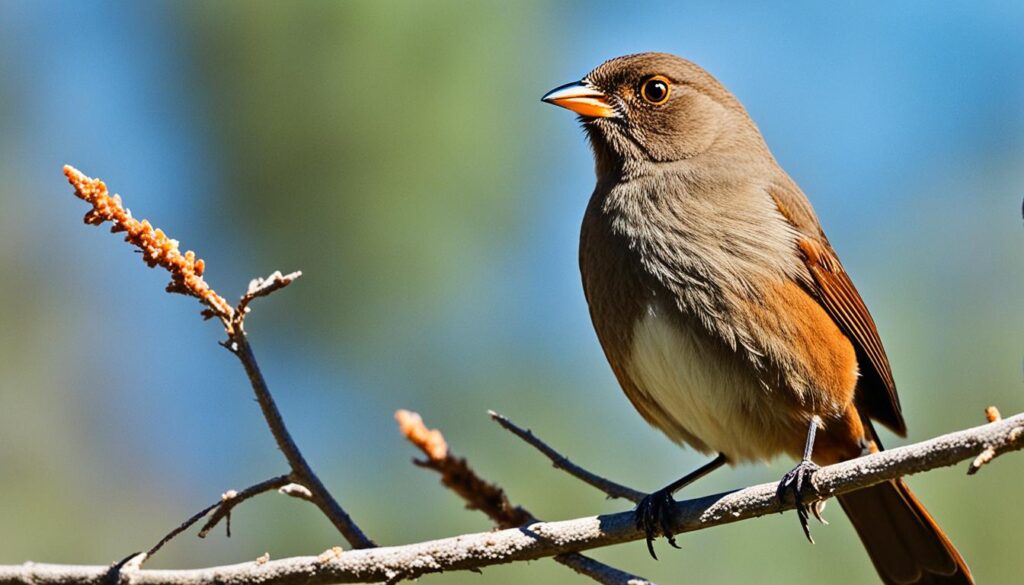
Observing California Towhees in their natural habitats or even in urban areas can provide bird enthusiasts with a unique glimpse into the avian diversity of California. Their ability to adapt to changing landscapes and their distinctive features make them a fascinating subject for birdwatchers and nature photographers.
Next, we will explore another captivating bird species of Northern California, the Oak Titmouse, known for its association with oak woodlands and cavity nesting behavior.
Oak Titmouse
The Oak Titmouse is a small, plain gray bird that is closely associated with the oak woodlands of California. With its small crest on the head and rapid, chattering calls, this species is easily recognizable. These birds primarily feed on insects and are commonly found in pairs or small family groups, actively foraging among the oak trees.
An interesting characteristic of the Oak Titmouse is its cavity nesting behavior. They often utilize natural cavities in trees or nest boxes for breeding and raising their young. Their preference for nesting in cavities makes them dependent on suitable habitat with mature oak trees. The forested areas of California’s oak woodlands provide the perfect environment for these cavity nesters to thrive.
The Oak Titmouse is a favorite among birdwatchers and backyard bird enthusiasts alike. They are attracted to feeders offering suet, seeds, or other high-energy foods. Providing a nesting box in your backyard can also attract these charming birds, allowing you to observe their nesting behaviors up close.
The Oak Titmouse’s association with oak woodlands and its habitat requirements make it an important indicator species for the health of these ecosystems. Protecting and preserving oak woodlands is crucial for the conservation of the Oak Titmouse and the many other species that rely on these unique habitats.
Key Features of the Oak Titmouse
- Closely associated with oak woodlands
- Small, plain gray bird with a small crest
- Feeds primarily on insects
- Forms pairs or small family groups
- Dependent on nesting in cavities
- Attracted to feeders offering suet or seeds
By understanding the habitat requirements and behaviors of the Oak Titmouse, birdwatchers and nature enthusiasts can further appreciate the importance of oak woodlands and contribute to their conservation efforts.
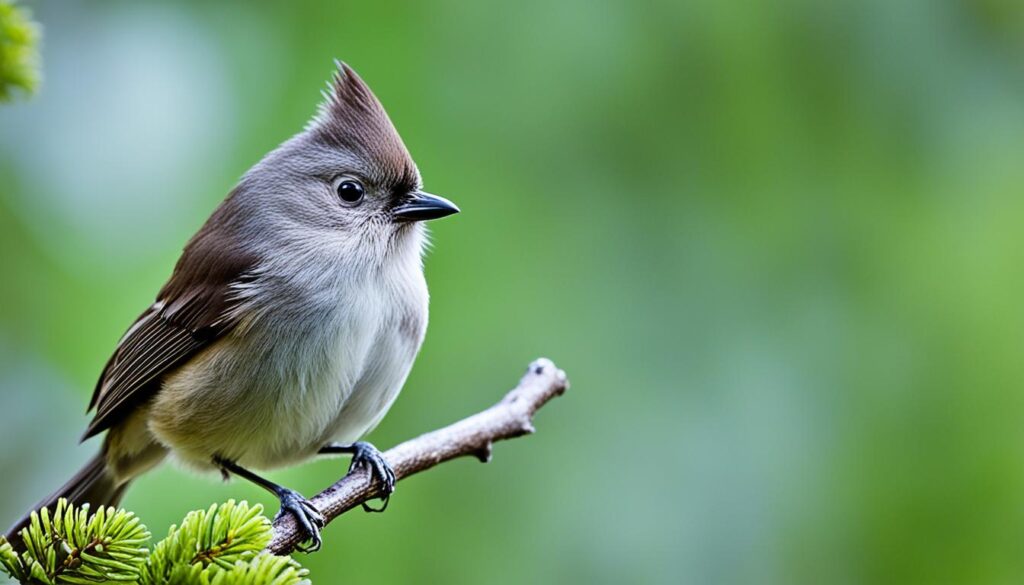
Cedar Waxwing
Cedar Waxwings are charming and sociable fruit-loving birds commonly found in California during the winter months. These elegant songbirds travel in large flocks, descending upon trees and shrubs laden with delicious berries, consuming them with gusto. With their vibrant plumage and distinctive red, wax-like droplets on their wing feathers, Cedar Waxwings add a burst of color to the winter landscape.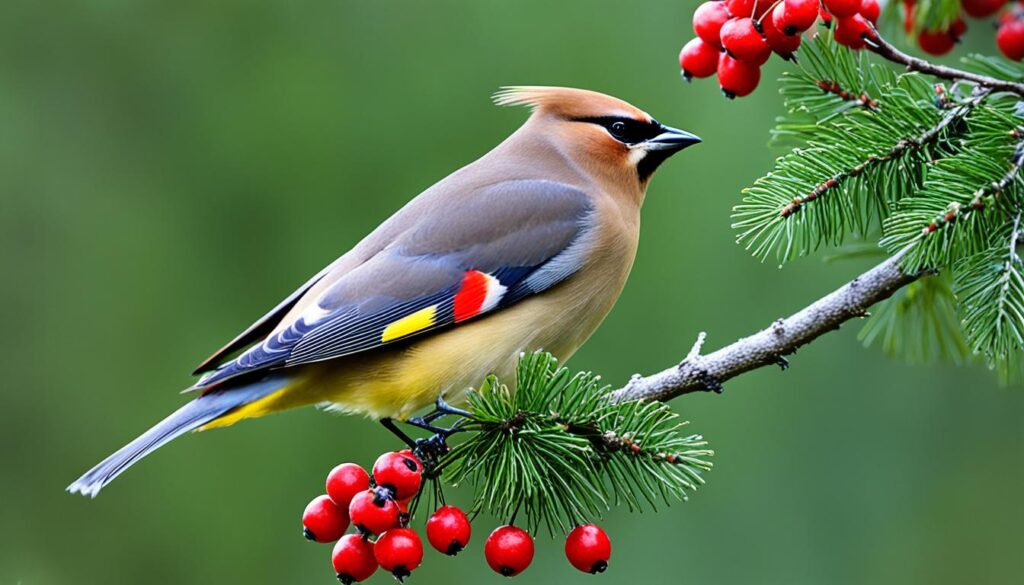
Nomadic Birds with a Passion for Fruit
One of the intriguing characteristics of Cedar Waxwings is their highly nomadic nature. These birds are constantly on the move in search of food, and their breeding and wintering territories can shift depending on the availability of fruit-bearing trees and shrubs. When their preferred food sources become depleted, they gracefully migrate to new areas in search of fresh feasting grounds.
A Feast for the Eyes and the Palate
When Cedar Waxwings gather in large flocks, their synchronized movements and collective feeding frenzy create a spectacle worth witnessing. Their efficient foraging technique allows them to swiftly remove the fruit from its branches, eating it whole or passing it to their flockmates in an elegant display of cooperative feeding. Observing Cedar Waxwings indulging in nature’s bounty is a visual feast for birdwatchers and nature enthusiasts alike.
“The sight of Cedar Waxwings devouring berries in unison is truly captivating. Their coordinated movements and melodious calls create a symphony of color and sound.”
Bird-Friendly Backyards
If you want to attract Cedar Waxwings to your backyard, the key is to provide them with a suitable habitat and a variety of fruit-producing native plants. These birds are known to visit gardens and backyard orchards, especially those with trees and shrubs that bear berries or fruits such as cherries, mulberries, and juniper berries. By creating a bird-friendly environment, you can enjoy the delightful presence of Cedar Waxwings and contribute to their conservation.
If you’re lucky enough to spot a Cedar Waxwing in your backyard, grab your camera and capture the moment. Their striking appearance and playful behavior make them a favorite subject for bird photographers.
California Scrub-Jay
California Scrub-Jays are lanky, blue jays that are common year-round residents in oak woodlands, dry shrublands, parks, and neighborhoods in coastal regions and foothills of California. They are known for their assertive, inquisitive, and vocal behavior, often visiting bird feeders. These jays are intelligent foragers, feeding on insects, fruits, seeds, nuts, and even small vertebrates. They are territorial birds and will defend their territories vigorously.
The Intelligent Foragers
The California Scrub-Jay is known for its highly adaptable feeding behavior. These birds have sharp beaks that allow them to access various food sources, making them versatile and intelligent foragers. They have been observed using tools, such as sticks and twigs, to extract insects from crevices or to pry open acorns and snails. This resourcefulness and ability to adapt their feeding strategies have contributed to their overall success as a species.
Territorial Behavior
California Scrub-Jays are fiercely territorial birds. They establish and defend their territories, which typically range from 2 to 12 acres in size. These territories provide them with ample food resources and nesting sites. The jays will vigorously defend their territories against other Scrub-Jays and even other bird species. They use a combination of vocal calls, aggressive displays, and physical confrontations to protect their territory from intruders.
“The California Scrub-Jay’s territorial behavior is fascinating to observe. These birds are not afraid to engage in confrontations and will vigorously defend their territory against any perceived threat. Their loud calls and aggressive displays serve as warnings to potential intruders.”

With their striking blue plumage and unique behaviors, California Scrub-Jays are captivating birds to observe in the wild. Whether they are foraging for food or vigorously defending their territories, these intelligent and territorial birds leave a lasting impression. The adaptability and resourcefulness of California Scrub-Jays make them an integral part of the diverse avian ecosystem in Northern California.
Cooper’s Hawk
The Cooper’s Hawk is a mid-sized bird-hunting hawk and the most common Accipiter species in California. With their long tails and rounded wings, these hawks are well-equipped to navigate through dense tree canopies in pursuit of their prey. Cooper’s Hawks primarily feed on medium-sized birds but also prey on small mammals. They are known for their agility and speed, making them formidable hunters in the sky.
One interesting aspect of Cooper’s Hawks is their size difference between males and females. Females are significantly larger than males, with the most pronounced size difference among all hawk species. This size disparity is believed to be advantageous for their hunting strategies, with females targeting larger prey and males focusing on smaller birds.
| Characteristics | Cooper’s Hawk | Sharp-shinned Hawk |
|---|---|---|
| Size | 17-20 inches (43-51 cm) | 9-13 inches (23-33 cm) |
| Wingspan | 31-37 inches (79-94 cm) | 20-27 inches (51-69 cm) |
| Weight | Female: 0.95-1.3 lbs (430-590 g) Male: 0.55-0.77 lbs (250-350 g) |
Female: 0.2-0.3 lbs (91-136 g) Male: 0.13-0.26 lbs (59-118 g) |
Cooper’s Hawks are often confused with their smaller cousin, the Sharp-shinned Hawk. They have similar plumage patterns and behaviors, making identification challenging. However, the size differences between the two species can be a helpful distinguishing factor. Additionally, Cooper’s Hawks tend to have a more rounded tail while Sharp-shinned Hawks have a squared-off tail.
If you’re lucky enough to spot a Cooper’s Hawk in the wild, take a moment to appreciate its hunting prowess and the remarkable size differences between males and females.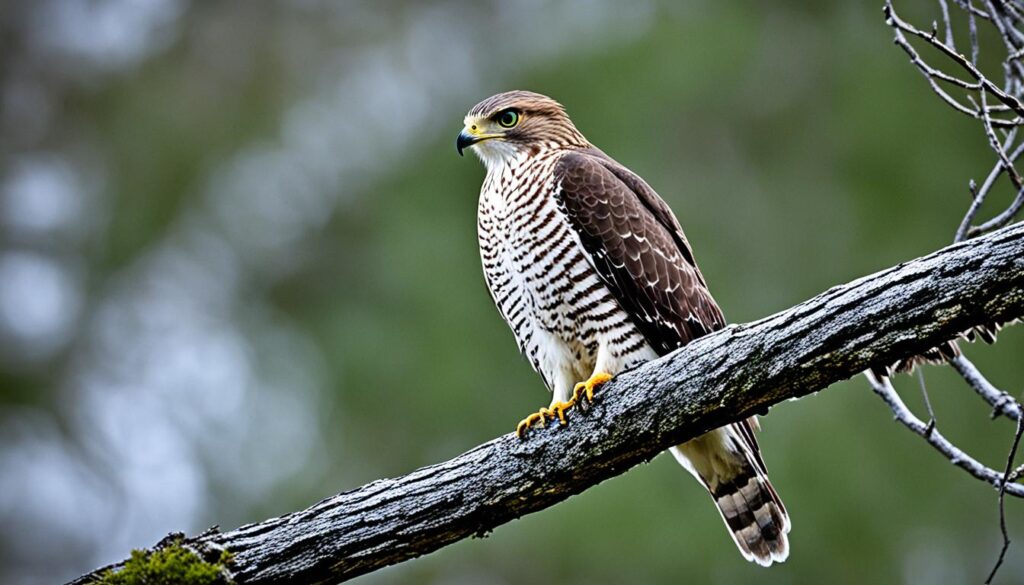
Yellow-rumped Warbler
The Yellow-rumped Warbler is a hardy and widespread species known for its distinctive yellow patch on its rump. This small songbird is a common wintering bird in California, where it can be found in small flocks among trees and shrubs. Unlike most warblers, the Yellow-rumped Warbler has a unique dietary preference that allows it to thrive in colder regions.
During the winter months, when food sources are scarce and temperatures drop, many warblers migrate to warmer climates. However, the Yellow-rumped Warbler has adapted to survive in colder regions by developing the ability to digest the waxy coating of berries. This unique dietary adaptation enables them to utilize an abundant food source during the winter, giving them a competitive advantage over other warblers.
The Yellow-rumped Warbler’s diet consists predominantly of berries, particularly those from trees such as junipers, wax myrtles, and bayberries. By consuming these high-energy fruits, the Yellow-rumped Warbler is able to sustain itself throughout the winter and remain in California’s colder regions when other warblers have migrated to more temperate areas.
“The Yellow-rumped Warbler’s ability to digest the waxy coating of berries gives it a significant advantage over other warblers during the winter months.”
In addition to its wintering habits, the Yellow-rumped Warbler also breeds in coniferous forests found in California’s mountain ranges. These forests provide suitable nesting habitats, where the warblers build cup-shaped nests using grasses, bark strips, and lichens. The female typically lays three to five eggs, which she incubates for about two weeks until they hatch.
Once the young have hatched, both parents are involved in feeding and caring for the nestlings. They primarily feed their offspring with high-protein food sources, such as insects and spiders, ensuring their healthy growth and development.
This adaptable and resourceful bird showcases the incredible diversity and survival strategies found among California’s avian species. Its ability to thrive in both wintering and breeding habitats, along with its unique dietary preference, makes the Yellow-rumped Warbler a remarkable and resilient species.
| Yellow-rumped Warbler | Description |
|---|---|
| Scientific Name | Setophaga coronata |
| Size | Approximately 5.5 – 6.3 inches (14 – 16 cm) in length |
| Weight | Average weight of 0.4 – 0.5 oz (10 – 14 g) |
| Appearance | Distinctive yellow patch on rump, gray back, white belly, streaked breast, and yellow patches on sides |
| Habitat | Coniferous and mixed forests, woodland edges, and shrubby habitats |
| Diet | Berries, insects, spiders |
| Conservation Status | Least Concern |
Chestnut-backed Chickadee
The Chestnut-backed Chickadee is a charming and sociable bird that calls the humid coniferous forests of coastal California its home. These non-migratory residents are often found in foraging flocks, joining forces with other chickadee species, nuthatches, and titmice, as they search for food and explore their woodland habitats. With their distinctive black caps and rich chestnut-colored backs, these small birds are easily recognizable.
One interesting aspect of the Chestnut-backed Chickadee is its eagerness to visit backyard feeders. These friendly birds are regular visitors to feeders that offer a variety of seeds or suet, providing bird enthusiasts with the opportunity to observe them up close and personal.
In recent years, the Chestnut-backed Chickadee has been expanding its geographic range. Once confined to the coastal areas of California, they have now colonized forest habitats in the central Sierra Nevada and even suburban areas in the eastern San Francisco Bay. This expansion demonstrates their adaptability and ability to thrive in different environments.
If you’re lucky enough to spot a Chestnut-backed Chickadee during your birdwatching adventures, take a moment to appreciate its cheerful presence and sociable nature. These delightful birds bring joy to both experienced birders and beginners alike.
“The Chestnut-backed Chickadee’s expanding range is a testament to its resilience and ability to adapt to changing environments.”
To better understand the characteristics and habits of the Chestnut-backed Chickadee, refer to the table below:
| Species | Scientific Name | Range | Size | Diet | Habitat |
|---|---|---|---|---|---|
| Chestnut-backed Chickadee | Poecile rufescens | Coastal California, central Sierra Nevada, eastern San Francisco Bay | 11-13 cm (4.3-5.1 in) | Insects, spiders, seeds, berries | Coniferous forests, suburban areas |
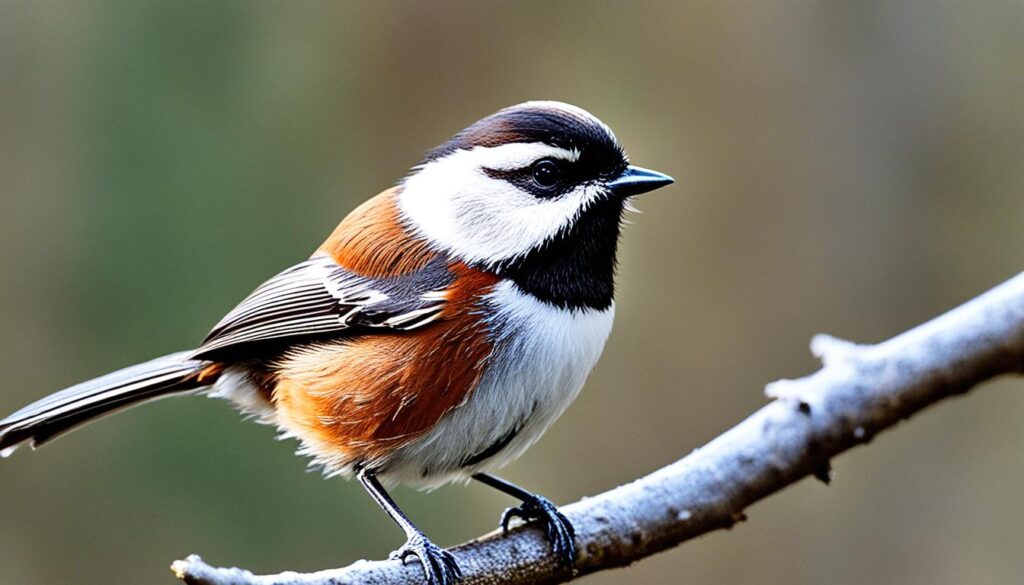
Observing the Chestnut-backed Chickadee
When observing the Chestnut-backed Chickadee, keep these tips in mind to enhance your birdwatching experience:
- Look for them in coniferous forests and suburban areas, paying attention to their distinct black caps and chestnut-colored backs.
- Listen for their cheerful, high-pitched calls and songs, which often consist of a series of clear, whistled notes.
- Set up a bird feeder with a variety of seeds and suet to attract these sociable birds to your backyard. Watch as they visit the feeder and interact with other bird species.
- Be patient and observant, as they may be part of a flock of other small birds, such as nuthatches and titmice.
By following these tips, you’ll increase your chances of encountering these delightful and expanding residents of California’s forests.
Overview of Common Birds in California
California is home to a diverse range of bird species, with over 684 documented species found within its borders. This abundance of avian life is thanks to the state’s wide variety of habitats, including forests, wetlands, farmlands, desert, scrublands, and coastal areas. The habitat diversity provides favorable conditions for a wide range of bird species to thrive.
While some species, such as the Tricolored Blackbird and California Gnatcatcher, are endangered due to habitat destruction, most birds in California are still common and can be easily observed. Whether you’re an experienced birdwatcher or just starting out, California offers ample opportunities to appreciate and learn about its feathered residents.
In addition to the iconic bird species that call California home, the state also attracts a multitude of migratory birds throughout the year. These birds use California as a vital stopover point on their long journeys, further enriching the birdwatching experience for enthusiasts.
Common Bird Species in California
Here are just a few examples of the common bird species you might encounter in California’s diverse habitats:
- American Robin: These thrushes are known for their vibrant orange breasts and cheerful songs. They can be found in a variety of habitats including gardens, parks, and woodlands.
- Mourning Dove: With their distinctive cooing calls, Mourning Doves are a familiar sight in urban areas, agricultural fields, and open habitats throughout the state.
- Anna’s Hummingbird: This charismatic hummingbird is a year-round resident in California, known for its iridescent plumage and incredible aerial acrobatics.
- California Quail: The state bird of California, these plump, ground-dwelling birds can often be seen in groups running along roadsides or foraging for seeds in grassy areas.
Bird Habitat Diversity in California
| Habitat Type | Main Bird Species |
|---|---|
| Coastal Areas | Brown Pelican, Heermann’s Gull, Western Snowy Plover |
| Mountains | Steller’s Jay, Mountain Bluebird, Townsend’s Solitaire |
| Wetlands | American Coot, Black-necked Stilt, White-faced Ibis |
| Deserts | Roadrunner, Greater Roadrunner, Cactus Wren |
| Forests | Northern Spotted Owl, Varied Thrush, Olive-sided Flycatcher |
| Farmlands | Western Meadowlark, Barn Owl, Swainson’s Hawk |
| Scrublands | California Scrub-Jay, California Thrasher, Sage Sparrow |
Regardless of where you find yourself in California, there is always a fascinating array of bird species waiting to be discovered. So grab your binoculars, explore the state’s habitat diversity, and get ready to witness the wonder of California’s common birds.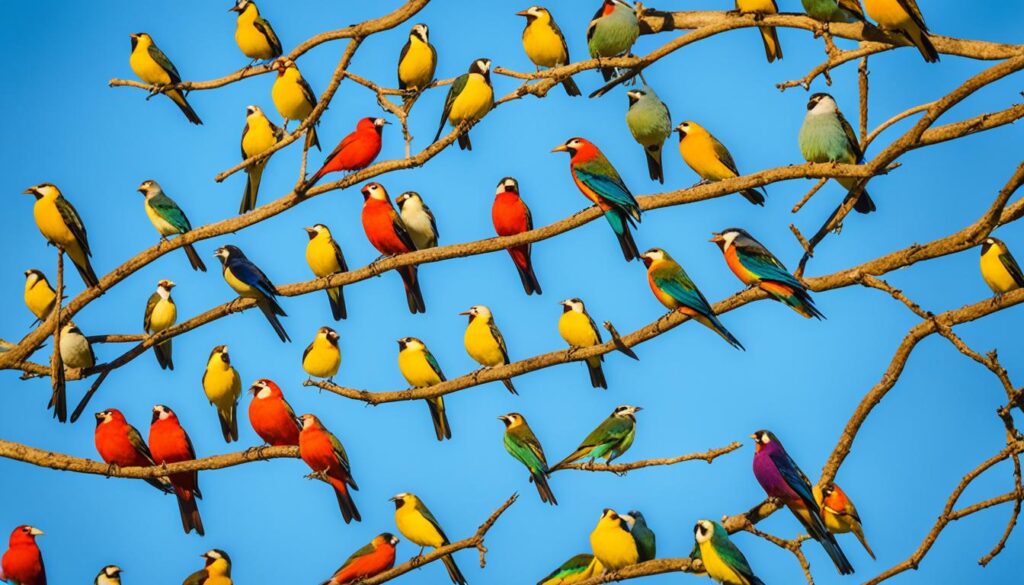
Most Common Birds in California
To help birdwatchers identify the most common birds in California, we have compiled a list based on eBird data. This list includes species that are frequently observed and provides information on their appearance, behavior, and habitats. From House Finches and American Crows to Anna’s Hummingbirds and White-crowned Sparrows, these birds can be found in various habitats across the state.
| Common Name | Scientific Name | Appearance | Behavior | Habitat |
|---|---|---|---|---|
| House Finch | Haemorhous mexicanus | Small size, brown or yellow plumage, red or orange crown | Social, often seen in flocks, frequent visitor to feeders | Urban areas, woodlands, deserts |
| American Crow | Corvus brachyrhynchos | Large size, all black plumage | Intelligent, vocal, opportunistic feeder | Wide variety of habitats, including urban areas |
| Anna’s Hummingbird | Calypte anna | Small size, iridescent green back, rose-pink throat | Aggressive, territorial, prominent aerial displays | Coastal areas, gardens, parks |
| White-crowned Sparrow | Zonotrichia leucophrys | Medium size, gray or brown plumage, bold black and white crown | Ground forager, migratory, distinctive song | Grasslands, shrublands, gardens |
These are just a few examples of the most common birds you may encounter while birdwatching in California. By familiarizing yourself with their characteristics and preferred habitats, you’ll be better equipped to identify and appreciate the diverse avian population in the state.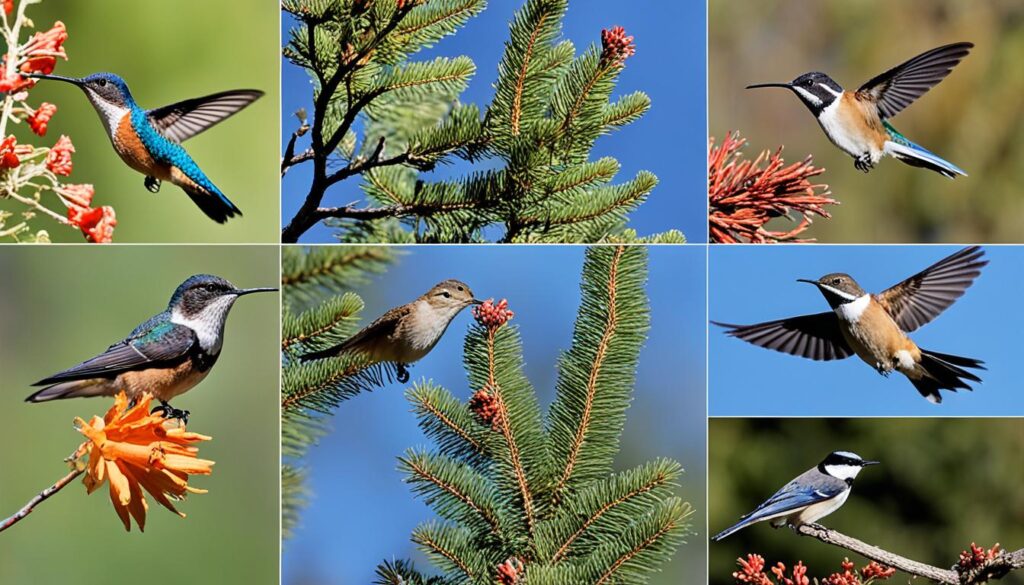
Birds of Northern California
Northern California offers a unique opportunity for bird photography enthusiasts. The region is home to a diverse range of bird species, including the American White Pelican, California Clapper Rail, and Western Bluebird. With its stunning landscapes and abundance of birdlife, Northern California provides ample opportunities to capture breathtaking photos of these feathered creatures in their natural habitats.
Whether you’re a seasoned bird photographer or just starting out, Northern California’s varied ecosystems offer endless possibilities for capturing stunning images. From the rugged coastline to the majestic mountains, each location presents its own unique bird species and photographic challenges. Here are some notable birds that you can find in Northern California:
| Bird Species | Key Features | Habitat |
|---|---|---|
| American White Pelican | Large size, white plumage, distinctive bill | Coastal areas, lakes, and wetlands |
| California Clapper Rail | Medium-sized, long-billed bird, mottled brown feathers | Marshes, estuaries, and tidal flats |
| Western Bluebird | Vibrant blue plumage, reddish-brown breast, white belly | Woodlands, open country, and suburban areas |
Photography Tips:
- Research bird behavior and habitats to increase your chances of sighting and photographing specific species.
- Invest in a quality telephoto lens to capture birds in their natural habitats without disturbing them.
- Experiment with different angles and perspectives to add variety to your bird photography portfolio.
- Utilize natural lighting and consider the time of day for optimal photo opportunities.
- Patience is key – be prepared to spend time observing and waiting for the perfect shot.
Exploring the birds of Northern California through photography allows you to appreciate the incredible beauty and diversity of nature. So grab your camera, head out to the stunning landscapes, and capture the essence of these magnificent birds in their natural habitats.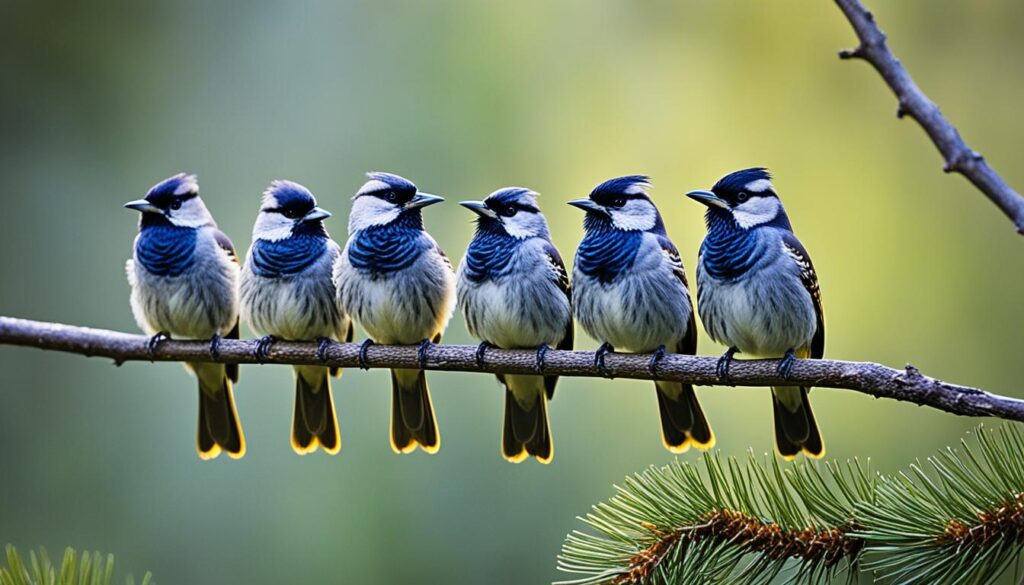
Birds in Flight in Northern California
Capturing photos of birds in flight can be both challenging and rewarding. Northern California’s diverse landscapes provide an ideal setting for capturing dynamic images of birds in action. Whether it’s soaring hawks, diving terns, agile swallows, or graceful herons, the region offers a wealth of opportunities to witness the beauty of birds in flight.
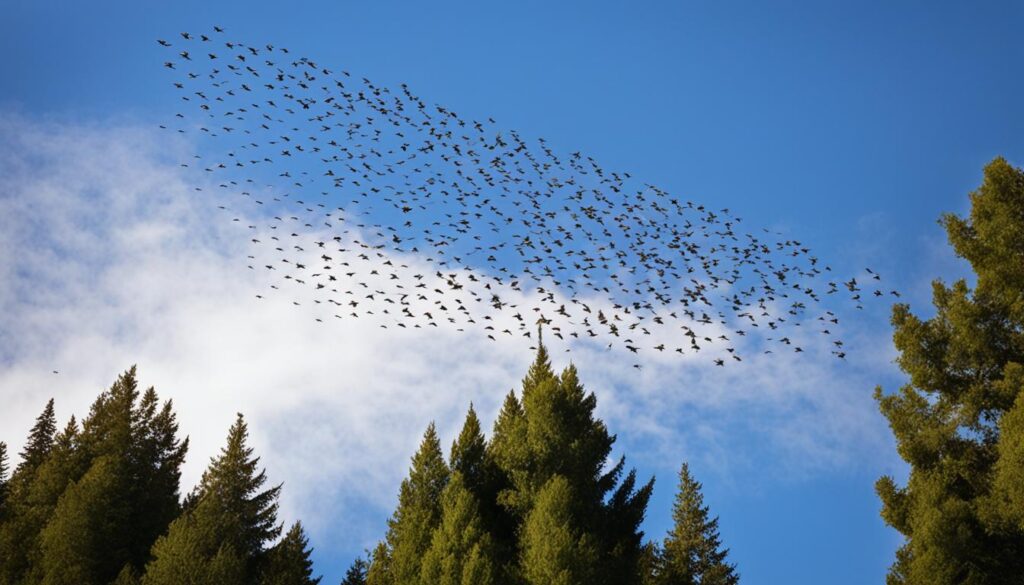
Photography Tips for Capturing Birds in Flight
Photographing birds in flight requires skill and practice. Here are some helpful tips to improve your chances of capturing stunning images:
- Use a fast shutter speed: Birds move quickly, so to freeze their motion, ensure your camera’s shutter speed is set to a high value, such as 1/1000 or faster.
- Focus on the eyes: The eyes are the focal point of any bird photo. Use autofocus or manual focus to ensure sharpness on the bird’s eyes.
- Anticipate the action: Birds in flight exhibit predictable patterns, such as banking or diving. Anticipate these movements to capture the perfect shot.
- Shoot in burst mode: Birds’ flight patterns can be unpredictable, so shooting in burst mode allows you to capture a series of photos in quick succession to increase your chances of getting the perfect shot.
- Experiment with composition: Play with different angles, perspectives, and framing to create visually interesting and dynamic compositions.
- Be patient: Patience is key when photographing birds in flight. Spend time observing their behavior and flight patterns to anticipate moments that make for captivating photographs.
Birds in Flight Photography Equipment Recommendations
| Equipment | Suggested Model |
|---|---|
| Camera Body | Nikon D500 |
| Telephoto Lens | Canon EF 100-400mm f/4.5-5.6L IS II USM |
| Tripod | Manfrotto 055 Carbon Fiber Tripod |
| Memory Cards | SanDisk Extreme PRO SDXC UHS-I Memory Card |
| Battery | Canon LP-E6N Lithium-Ion Battery |
“Photography is a way of feeling, of touching, of loving. What you have caught on film is captured forever… It remembers little things, long after you have forgotten everything.” – Aaron Siskind
With these photography tips and the right equipment, you’ll be well on your way to capturing stunning images of birds in flight in Northern California. Remember to respect the birds’ natural habitats and maintain a safe distance while enjoying the beauty of these graceful creatures in action.
Conservation of Birds in Northern California
Protecting bird populations and their habitats is crucial for the long-term survival of bird species in Northern California. Various organizations and conservation efforts are working tirelessly to preserve and restore critical habitats, such as wetlands and forests, that are essential for nesting, feeding, and migration. Additionally, promoting bird-friendly practices is vital in ensuring the well-being of these feathered creatures.
Promoting Bird-Friendly Practices
To contribute to the conservation of bird species in Northern California, individuals and communities can adopt several bird-friendly practices:
- Reducing Pesticide Use: Avoiding the use of harmful pesticides minimizes the risk of contaminating bird habitats and food sources.
- Providing Nesting Boxes: Installing nesting boxes in suitable locations can provide additional nesting opportunities for cavity-nesting birds.
- Planting Native Vegetation: Choosing native plants in gardens and landscaping projects helps attract birds by providing them with familiar food sources and shelter.
Conservation Efforts and Organizations
Several organizations in Northern California play a crucial role in bird conservation:
- Audubon California: Audubon California focuses on protecting priority bird species and their habitats through science-based advocacy and community engagement.
- California Audubon Society: The California Audubon Society works to conserve and restore vital bird habitats, promote wildlife-friendly policies, and engage communities in bird education and conservation.
- San Francisco Bay Bird Observatory: This organization conducts bird research, promotes bird conservation, and works on habitat restoration projects.
“Conserving bird habitats is not only essential for bird populations but also for the overall health of our ecosystems. Every effort, no matter how small, contributes to the protection of these beautiful creatures and the natural world we share.” – John Davis, Conservation Biologist
Habitat Protection and Restoration
Habitat protection and restoration efforts are crucial in ensuring the survival of bird species in Northern California. Wetlands, forests, and other critical habitats serve as essential breeding grounds, foraging areas, and stopover sites during migration. By preserving and restoring these habitats, we can support the diverse bird populations that rely on them.

| Habitat | Key Bird Species |
|---|---|
| Wetlands | American White Pelican, California Clapper Rail |
| Forests | Acorn Woodpecker, Northern Pygmy-Owl |
| Coastal Areas | Western Bluebird, Black Oystercatcher |
Preserving and restoring these habitats involves land acquisition, implementing conservation strategies, and maintaining sustainable management practices. It is crucial for individuals, organizations, and policymakers to work hand in hand to ensure the long-term survival of bird species in Northern California and protect the natural beauty this region offers.
Conclusion
Northern California is a birdwatcher’s paradise, offering a rich diversity of common bird species in its various habitats. From the Dark-eyed Junco and Allen’s Hummingbird to the California Scrub-Jay and Yellow-rumped Warbler, these avian residents bring life and vibrancy to the region.
By exploring the diverse landscapes of Northern California, bird enthusiasts can immerse themselves in the beauty and wonder of the avian world. Each species has its unique characteristics and behaviors, from the winter residents like the Dark-eyed Junco to the nomadic Cedar Waxwing. Observing these birds in their natural habitats provides an opportunity to witness their mesmerizing courtship displays, acrobatic flights, and distinctive calls.
The conservation of bird species in Northern California is of utmost importance to preserve their populations and habitats. By supporting organizations and initiatives focused on habitat protection, birdwatchers can contribute to the long-term survival of these common birds. Additionally, adopting bird-friendly practices such as reducing pesticide use and providing nesting boxes can create a conducive environment for these feathered inhabitants.
Embark on a rewarding journey to explore the common birds of Northern California and discover the endless marvels of the avian world. With their captivating plumage, enchanting songs, and remarkable behaviors, these birds enrich the natural landscapes and create a harmonious connection between humans and wildlife in this picturesque region.FAQ
What are some common birds in Northern California?
What is unique about the Dark-eyed Junco?
When do Allen’s Hummingbirds arrive in California?
Where can California Towhees be found?
What is notable about Oak Titmice?
Are Cedar Waxwings nomadic?
Where are California Scrub-Jays commonly found?
How can Cooper’s Hawks be distinguished?
What makes Yellow-rumped Warblers unique?
Where can Chestnut-backed Chickadees be found?
How many bird species are there in California?
What are the most common birds in California?
What bird species can be found in Northern California?
What tips can help in capturing photos of birds in flight in Northern California?
How can bird conservation be promoted in Northern California?
What makes Northern California a birdwatcher’s paradise?
Paul’s love for animals knows no bounds. As a dedicated writer and animal lover, Paul brings a unique perspective to our team. His firsthand experiences with various animals enrich our content and provide valuable insights into their behavior and needs. Whether he’s sharing tips for pet care or shedding light on pressing conservation issues, Paul’s passion for animals shines through in everything he does.
Miniature horses
Mini Horse Heat Cycles: When Do They Start?
Discover the breeding cycle of mini horses. Learn when-do-mini-horses-go-into-heat and manage their care with our expert insights.

Mini horse heat cycles are vital for breeding management. By understanding these cycles, owners can plan breeding and care effectively. Normally, these cycles start when the horses are 12 to 18 months old. This is similar to larger horses, but with unique differences.
Factors like light and temperature play a role. A cycle lasts about 22 days. The “heat” stage is 3 to 7 days long. This piece dives into the details of mini horse cycles, including when they start and how to spot them.
From April to October, mini horses have their heat cycles. Daylight affects these cycles, which is key for breeding plans. Knowing the signs and behaviors during this time is essential. It helps improve the chances of successful mini horse breeding.
Key Takeaways
- The estrous cycle in mares lasts about 21–22 days and includes an estrus phase of 3 to 7 days.
- Mares typically start cycling between 12 and 18 months of age.
- Heat cycles generally occur from April through October due to daylight exposure.
- Ovulation occurs 24 to 48 hours before the end of the heat phase.
- Signs of being in heat include behavioral changes and specific physical indicators.
- Mares do not experience heat during the winter months; awareness of this helps in managing breeding cycles.
- Natural and hormonal treatments are available for managing heat-related issues in mares.
Understanding Mini Horse Reproductive Cycles
Knowing about mini horses’ reproductive cycles is key for good breeding and care. These cycles last about 21 to 22 days. They involve changes in the mare’s body that affect when she can have babies.
Overview of the Estrous Cycle
The estrous cycle has two phases: estrus and diestrus. Estrus, or the heat period, is when the mare is ready to mate. It lasts 3 to 7 days. Ovulation happens 24 to 48 hours before estrus ends. This time is important for breeding. Then, the mare goes into diestrus for about 14 days when she won’t mate with stallions.
Seasonal Patterns in Mini Horses
Mini horses breed in a pattern that depends on the time of year. They breed mostly in late spring and early fall. This schedule makes sure babies are born when the weather is not too cold. Longer days in spring and summer start their breeding season.
| Cycle Phase | Duration | Behavioral Signs |
|---|---|---|
| Estrus | 3-7 days | Raised tails, urine squirting, vulva winking |
| Diestrus | 14 days | Rejection of stallion |
Understanding how mini horses’ estrous cycles work is crucial for breeding success. Knowing about their seasonal breeding helps manage mare and stallion meetings better.
When Do Mini Horses Go Into Heat?
It’s important to know when mini horses go into heat, especially if you’re into breeding. They usually have their first heat cycle between 12 and 18 months old. The exact time can vary due to breed and health. Knowing this helps owners get ready for breeding.
Typical Age Range for First Heat
Mini horses begin their heat cycles between 12 and 18 months. Some may start early, showing they’re ready to reproduce. Others might be late, which could mean health issues. They don’t go through menopause, but older mares might find it harder to breed and have longer heat cycles.
Frequency of Heat Cycles
Mini horses have a heat cycle every 21 to 22 days during breeding season. This is from April to October. There’s an estrus phase lasting 4 to 7 days when the mare is ready to mate. Then comes a 14-day diestrus phase when she’s not in heat. The number of cycles can change based on health and where they live.

Signs of Heat in Mini Horses
Knowing the signs of heat in mini horses is key for good breeding management. It’s important to recognize both how they act and physical signs during the mare’s heat cycle. This knowledge improves care and breeding efforts.
Behavioral Changes
Mares in heat show different behaviors. You might notice:
- Increased restlessness and pacing.
- Vocalizations that are louder or happen more often.
- Postures like “camping,” where they stand with back legs apart.
- Lifting of the tail, which means they’re ready to mate.
- They may act more aggressive toward other horses.
Physical Indicators of Heat
There are also physical signs that show a mare is in heat. Spotting these helps with making breeding choices at the right time. You might see:
- A yellowish-white discharge from the vulva.
- They might urinate more often, known as “pissing.”
- The clitoris may get bigger.
These signs can pop up fast and differ from mare to mare. Keeping a close watch helps in finding the best time for breeding.
| Behavioral Indicators | Physical Indicators |
|---|---|
| Restlessness | Yellowish-white discharge |
| Vocalizations | Frequent urination |
| Camps out (spreading legs) | Enlargement of clitoris |
| Tail lifting | |
| Aggressive tendencies |
Conclusion
It’s vital to understand the details of mini horse heat cycles for good breeding and care. This summary shows how important it is to know when these cycles happen and their signs. Mares have heat cycles every 21 days that last four to seven days.
Knowing this helps owners make smart breeding choices. This ensures their mini horses are healthy and happy.
Also, knowing when mini horses usually reproduce, in spring and early fall, helps owners plan better. Addressing silent heats or ovarian tumors is key for good reproductive health. This way, equestrians can improve how they breed and take care of their mares during these times.
By understanding and taking the right steps, owners can help their mini horses stay reproductive healthy. Being aware and ready, including knowing when to call the vet or how to feed them, makes breeding better. In the end, having this knowledge lets owners take great care of their horses during important times, which is good for the mares and their babies.
FAQ
When do mini horses go into heat?
What are the signs of heat in mini horses?
How is the estrous cycle in mini horses structured?
How do seasonal patterns affect mini horse heat cycles?
Can older mini horse mares still breed?
What should owners be aware of regarding individual differences in heat cycles?
Paul’s love for animals knows no bounds. As a dedicated writer and animal lover, Paul brings a unique perspective to our team. His firsthand experiences with various animals enrich our content and provide valuable insights into their behavior and needs. Whether he’s sharing tips for pet care or shedding light on pressing conservation issues, Paul’s passion for animals shines through in everything he does.
Miniature horses
How Much Is a Miniature Horse? Cost Guide
Discover the cost of owning a miniature horse. Our guide breaks down prices and factors affecting how-much-is-miniature-horse.

Planning to get a miniature horse is exciting. However, understanding the cost is crucial. The price for a miniature horse differs due to size, shape, and lineage. Adoption fees are generally between $300 to $450. But, buying from a good breeder might cost $1,900 to $9,000. And for those looking at special or high-quality breeds, be ready to spend up to $200,000.
Remember, buying the horse is just the beginning of your spending. The lasting costs matter too. You’ll need a good living space for them and money for food and health care every month. Proper planning ensures your miniature horse is not just surviving but living well.
Key Takeaways
- The price of miniature horses can range from $300 in adoptions to over $200,000 for rare breeds.
- Initial purchase costs vary widely based on breeder reputation and horse quality.
- Monthly feeding costs for miniature horses are generally around $25.
- Ongoing expenses for health care and environmental maintenance must be factored into budget considerations.
- Preparation is vital to ensure the well-being of your miniature horse.
- Owning a miniature horse requires a comprehensive understanding of both upfront and recurring costs.
Understanding the Purchase Costs of Miniature Horses
Buying a miniature horse comes with different costs. You can adopt one or buy directly from breeders. Knowing the price ranges can help you make a good choice.
Adoption Options and Costs
Adoption is a cheaper way to get a miniature horse. The costs can be from $300 to $450. This includes vet care and some basic needs. By adopting, you save money and give a horse a new home.
Breeder Prices and Value
Breeder prices for miniature horses differ a lot. On average, they cost between $1,900 and $8,000. But, horses with special pedigrees can cost much more. Horses with show-winning backgrounds or AMHA registration usually cost over $7,500.
Unregistered horses are cheaper, often under $2,000. This makes them good for those on a budget.
Rare Breeds and High-End Miniature Horses
Looking for rare breeds can push prices up. Horses with unique looks may cost over $10,000. Miniature horses that look like their larger breed counterparts can also be quite pricey. For instance, black stallions like Unique Superstition have been sold for as much as $45,000.
Their foals can be valued at $6,000 to $10,000 each. If you want a high-end miniature horse, be ready to spend a lot.
| Type of Purchase | Cost Range | Notes |
|---|---|---|
| Adoption | $300 – $450 | Includes preliminary veterinary care. |
| Unregistered Breeders | Below $2,000 | Lower price range for budget shoppers. |
| Registered Breeders | $1,900 – $8,000 | Average cost; variability based on pedigree. |
| Rare Breeds or Unique Markings | Over $10,000 | High demand increases value. |
| High-End Stallions | Up to $45,000 | Exceptional breeding and genetics. |
Ongoing Monthly Costs of Owning a Miniature Horse
Having a miniature horse means dealing with several monthly costs. These can change a lot based on what the horse needs. It’s important to know these costs to plan your budget for your new friend.
Feeding Expenses
Feeding a miniature horse every month can cost between $60 and $100. The feed’s type, pasture access, and the horse’s diet needs affect this price. A mix of hay, grains, and supplements usually makes up their diet. Good pasture access can lower the cost since mini horses do well on grass.
Health Care and Maintenance
Caring for a miniature horse’s health is key, and the costs can differ a lot. Monthly, you might spend anywhere from $0 to more than $200. This covers vet visits, medicine, and keeping the horse healthy. Regular check-ups, vaccines, and dental work keep them in good shape. Grooming also matters for their health. It can cost between $0 and $50 each month, based on who does the grooming.
Environmental Maintenance Costs
Owning a miniature horse also brings costs for their living space. These costs usually fall between $10 and $100 monthly. They cover stall cleaning, new bedding, and looking after the horse’s hooves. It’s vital to consider these when thinking about the monthly expenses of having a mini horse.
How Much Is Miniature Horse Ownership Overall?
Knowing the costs of owning a miniature horse is important. It covers from the start-up costs to monthly outgoings. Knowing these costs helps avoid surprises later on.
Initial Setup and Supplies
The initial setup cost for a miniature horse can vary. It might start at $200 and can go up to more than $5,000. This includes:
- Fencing to provide a safe environment
- Housing structures like barns or shelters
- Basic care supplies such as halters, grooming tools, and feeding equipment
It’s vital to prepare your outdoor spaces well. This ensures your miniature horse adjusts easily to its new home.
Training and Boarding Expenses
Training and boarding costs change based on where you are and your horse’s needs. Basic barn care can cost about $100 monthly. More deluxe boarding services can range from $300 to $700. Training prices will depend on what training your horse needs and what you want.
Additional Considerations and Budgeting Tips
You also need to think about recurring costs such as:
- Feeding, which costs between $25 to $40 monthly for hay and grain
- Regular vet visits, with a yearly cost of at least $100
- Farrier services, costing about $15 to $20 per visit
- Dental care, usually between $60 to $100 per visit
Keeping good records of your spending will help you manage future costs. Enjoying your miniature horse journey starts with good budgeting.
Conclusion
Keeping a miniature horse is a thrilling adventure with lots of friendship and happiness. But, it’s important to know what it costs to own one. The buying price alone can range widely. From just a few hundred bucks to thousands, depending on the horse’s breed and family history. Then, you have to think about the money needed for food, vet visits, and housing.
This piece gives a rundown of the costs like hoof care, teeth check-ups, and making sure they don’t eat too much. You might spend between $50 and $150 every month on care. This means the yearly cost could be anywhere from $600 to $1,800. It’s also crucial to have enough room for them and keep their living area nice.
In the end, choosing to get a miniature horse means doing your homework on finances and making sure they have a good place to live. With the right budgeting and loads of love, having a miniature horse can be rewarding. It’s a decision that can lead to lots of happiness for years to come.
FAQ
What is the typical cost of adopting a miniature horse?
How much do miniature horses cost when purchased from a breeder?
FAQ
What is the typical cost of adopting a miniature horse?
Adoption fees for miniature horses are usually between 0 and 0. This price often includes vet care and other basics. It’s a good deal for many who want to own one.
How much do miniature horses cost when purchased from a breeder?
When buying from a breeder, a miniature horse’s price tags range from
FAQ
What is the typical cost of adopting a miniature horse?
Adoption fees for miniature horses are usually between $300 and $450. This price often includes vet care and other basics. It’s a good deal for many who want to own one.
How much do miniature horses cost when purchased from a breeder?
When buying from a breeder, a miniature horse’s price tags range from $1,900 to $9,000. The cost varies greatly. It depends on the horse’s breed, age, and family background.
Are there any rare breeds of miniature horses that are more expensive?
Yes, some rare miniature horse breeds can be way more expensive, with prices over $200,000. Their unique traits and background make them highly valuable.
What are the monthly feeding expenses for a miniature horse?
The cost to feed a miniature horse monthly is between $60 and $100. It depends on their diet, if they graze, and if they need extra supplements.
How much should I budget for initial setup costs for a miniature horse?
Getting started with a miniature horse can cost from $200 to $5,000 or even more. Costs include fencing, shelter, care items, and getting the yard ready.
What health care expenses should I expect when owning a miniature horse?
Health care costs for a miniature horse can vary. But, plan for regular vet visits, shots, and other medical needs. These are essential for keeping your horse healthy.
Are there any additional costs to consider for owning a miniature horse?
Yes, think about the cost of training, boarding, and keeping their environment. Include these in your budget for responsible and long-term care.
,900 to ,000. The cost varies greatly. It depends on the horse’s breed, age, and family background.
Are there any rare breeds of miniature horses that are more expensive?
Yes, some rare miniature horse breeds can be way more expensive, with prices over 0,000. Their unique traits and background make them highly valuable.
What are the monthly feeding expenses for a miniature horse?
The cost to feed a miniature horse monthly is between and 0. It depends on their diet, if they graze, and if they need extra supplements.
How much should I budget for initial setup costs for a miniature horse?
Getting started with a miniature horse can cost from 0 to ,000 or even more. Costs include fencing, shelter, care items, and getting the yard ready.
What health care expenses should I expect when owning a miniature horse?
Health care costs for a miniature horse can vary. But, plan for regular vet visits, shots, and other medical needs. These are essential for keeping your horse healthy.
Are there any additional costs to consider for owning a miniature horse?
Yes, think about the cost of training, boarding, and keeping their environment. Include these in your budget for responsible and long-term care.
Are there any rare breeds of miniature horses that are more expensive?
What are the monthly feeding expenses for a miniature horse?
How much should I budget for initial setup costs for a miniature horse?
What health care expenses should I expect when owning a miniature horse?
Are there any additional costs to consider for owning a miniature horse?
Paul’s love for animals knows no bounds. As a dedicated writer and animal lover, Paul brings a unique perspective to our team. His firsthand experiences with various animals enrich our content and provide valuable insights into their behavior and needs. Whether he’s sharing tips for pet care or shedding light on pressing conservation issues, Paul’s passion for animals shines through in everything he does.
Miniature horses
Miniature Horse Breeders: Where to Find Your Dream Mini!
Miniature horse breeders offer a gateway to discovering your perfect companion, but finding the right one requires careful research and connections.
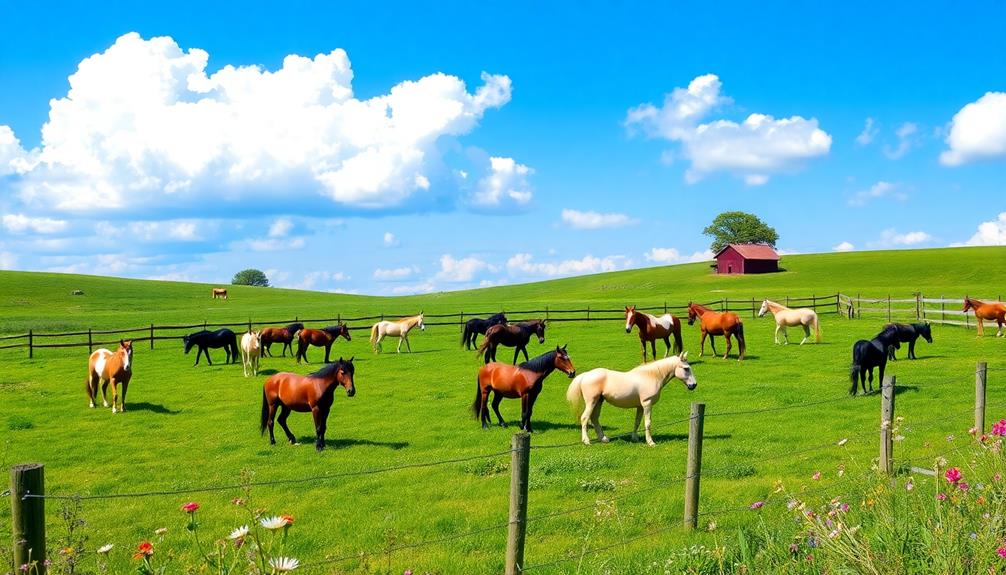
To find your dream miniature horse, start by connecting with reputable breeders who prioritize health and temperament. Check out established names like Little America Mini Horses and Bear Farms, where you can explore diverse colors and sizes. Platforms like DreamHorse and Lil' Beginnings also help you discover quality options. Make sure to evaluate their breeding practices and seek breeders who follow AMHA guidelines for a better chance of a healthy horse. Engaging in the miniature horse community can provide valuable insights and support. If you're curious about specific breeders or buying tips, there's much more to uncover.
Key Takeaways
- Explore reputable breeders like Little America Mini Horses and Bear Farms for diverse options and excellent temperament in miniature horses.
- Utilize online platforms such as DreamHorse and Lil' Beginnings to connect with trusted breeders and find your ideal mini.
- Attend AMHA shows to discover show-quality miniature horses and network with experienced breeders for guidance.
- Prioritize breeders who adhere to AMHA guidelines, focusing on health, temperament, and genetic diversity in their breeding practices.
- Engage with local and online communities for support, resources, and shared experiences in miniature horse ownership.
Understanding Miniature Horse Breeds

When it comes to understanding miniature horse breeds, it's important to know that these charming equines stand 34 inches tall or shorter at the withers.
Miniature horses have gained popularity for their affectionate nature and versatility, making them perfect companions and therapy animals. The American Miniature Horse Association plays a significant role in this world, maintaining breed standards and ensuring all registered horses come from reputable breeding practices.
When you look into breeding miniature horses, the focus lies on maintaining desirable traits like temperament and health. A well-bred miniature horse should exhibit a friendly demeanor, making them suitable for family environments and various activities.
It's imperative to take into account that responsible breeding practices also prioritize the overall health of these horses, ensuring they thrive throughout their lives.
You'll find a range of color options in miniature horses, from striking appaloosas and pintos to numerous solid colors.
This variety allows you to choose a horse that not only fits your lifestyle but also captures your heart. Understanding these aspects will help you make informed decisions as you navigate the world of miniature horses.
Top Breeders to Consider

If you're looking to acquire a miniature horse, considering reputable breeders is essential to guarantee you find a healthy and well-tempered companion.
Here are some top breeders you should consider:
- Little America Mini Horses (Buda, TX): Known for one of the largest herds globally, offering a stunning variety of colors and sizes.
- Bear Farms (Shawnee, KS): With over 40 years in the industry, they focus on producing high-quality miniature horses known for their excellent temperament and health.
- American Miniature Horse Association (AMHA): Many esteemed breeders participate in AMHA shows, showcasing show-quality horses with proven competitive success.
- Lil' Beginnings: An online platform providing resources and listings for connecting buyers with reputable breeders.
- DreamHorse: Another great online marketplace where you can find a variety of miniature horses for sale, often from trusted breeders.
Evaluating Breeding Practices

When evaluating breeding practices, you'll want to focus on the breeder's commitment to responsible standards and their emphasis on health and temperament.
A strong breeding program should also prioritize genetic diversity to enhance the quality of miniature horses.
Responsible Breeding Standards
Responsible breeding standards play an essential role in ensuring the quality and health of miniature horses. When you're looking for your dream mini, it's important to evaluate breeders based on their practices.
Here are some key aspects to take into account:
- Health and Temperament: Breeders should select stock based on these traits to guarantee quality offspring.
- Genetic Diversity: Prioritizing genetic diversity helps avoid inbreeding and reduces hereditary health issues.
- Compliance with Standards: Ethical breeders adhere to the guidelines set by the American Miniature Horse Association, ensuring authenticity.
- Documentation: Look for breeders who provide proper documentation for registration transfer, which guarantees lineage.
- Veterinary Care and Nutrition: A commitment to regular veterinary care and proper nutrition is essential for the overall well-being of the horses.
Health and Temperament Focus
Evaluating the health and temperament of miniature horses is essential for ensuring you choose a quality companion. Responsible breeders prioritize health by conducting regular veterinary check-ups and performing genetic testing. This commitment helps guarantee that the horses you're considering are well-cared for and less prone to health issues.
When it comes to temperament, ethical breeding practices matter. Reputable breeders select for calm and friendly dispositions, aiming to produce well-adjusted offspring. They understand that a horse's temperament can greatly affect your experience as an owner. Many breeders also engage in socialization practices from a young age, fostering positive interactions with humans and other animals. This enhances the horse's suitability as a companion.
Additionally, responsible breeders adhere to breed standards set by organizations like the American Miniature Horse Association. These guidelines cover conformation and health, ensuring you're supporting quality breeding practices.
A breeder's commitment to ethical breeding also extends to providing prospective owners with information on care and training, promoting a healthy and productive relationship between you and your new miniature horse. Overall, focusing on health and temperament lays the foundation for a rewarding companionship.
Genetic Diversity Importance
Understanding the significance of genetic diversity in miniature horse breeding is essential for ensuring the overall health and wellness of the breed. By prioritizing genetic diversity in your breeding practices, you can greatly reduce the risk of health issues that may arise from inbreeding.
Here are some key benefits to reflect upon:
- Reduced risk of hereditary diseases: A diverse gene pool helps ward off genetic disorders.
- Improved conformation and temperament: Diverse breeding stock can produce horses that are better suited for companionship and performance.
- Unique color patterns and sizes: Selecting from various bloodlines enhances the potential for unique traits that attract buyers.
- Healthier offspring: Responsible breeders conduct genetic testing to identify potential health issues early on.
- Long-term sustainability: Maintaining genetic diversity allows for ongoing improvements and adaptations to meet changing needs.
Finding Miniature Horses for Sale

When you're on the hunt for miniature horses for sale, reputable breeders should be your first stop. Breeders like Little America Mini Horses offer extensive inventories, showcasing a diverse selection based on color, size, and temperament. You can trust that many of these horses are registered with the American Miniature Horse Association, ensuring they meet breed standards and authenticity.
In addition to visiting breeders, don't overlook online platforms such as DreamHorse, HorseTopia, and Lil' Beginnings. These sites provide thorough listings and resources, connecting you with various breeders across the country.
If you're searching for show-quality miniature horses, consider attending auctions or reaching out to breeders specializing in competitive bloodlines. Many of these horses can be prepped for participation in AMHA shows, enhancing your experience.
For international buyers, rest assured that assistance with shipping logistics and quarantine requirements can make purchasing miniature horses from breeders worldwide a reality.
Whether you're looking for a new companion or a potential show star, finding the right miniature horse is within your reach.
Show Circuit Opportunities

Participating in the show circuit offers you a unique opportunity to not only showcase your miniature horse but also engage with a vibrant community of enthusiasts.
The American Miniature Horse Association hosts numerous shows throughout the year, where you can display your prized mini, whether it's a future AMHA World Reserve Champion or a beloved family pet.
Here are some show circuit opportunities you can take advantage of:
- Compete in various classes tailored for different skill levels.
- Gain recognition among fellow breeders and enthusiasts.
- Connect with experienced breeders who can guide you through preparations.
- Attend educational sessions to enhance your showing skills.
- Build lasting friendships within the miniature horse community.
Community Resources and Support
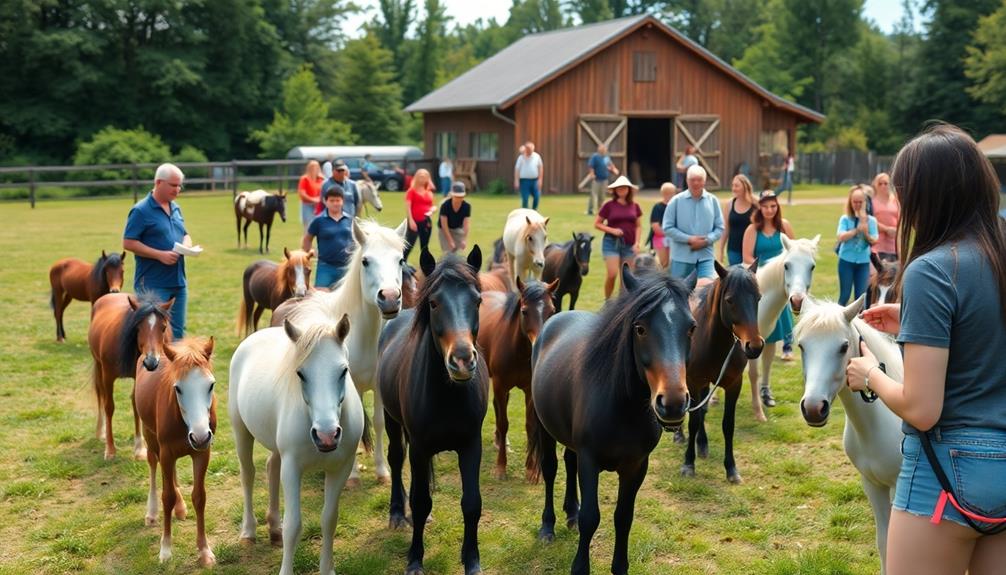
Connecting with local breeders can really enhance your journey in miniature horse ownership.
Engaging in online communities not only offers support but also gives you access to valuable insights and experiences from fellow enthusiasts.
Together, these resources help you make informed decisions and build lasting relationships in the miniature horse world.
Local Breeders Network
Local breeders serve as invaluable resources for anyone looking to find the perfect miniature horse, offering not only a diverse selection but also personalized guidance throughout the purchasing process.
By engaging with local breeders, you can gain insights that go beyond what you might find online.
Consider the benefits of local breeders and community engagement:
- Diverse Selection: Access a variety of miniature horses suited to your preferences.
- Personalized Guidance: Get tailored advice based on your specific needs and lifestyle.
- Success Stories: Hear firsthand experiences from other buyers who found their dream mini.
- Community Connections: Foster relationships with fellow enthusiasts who share your passion.
- Curated Resources: Gain access to knowledgeable discussions about care and breeding practices.
Online Community Engagement
Engaging with online communities can enhance your experience in the world of miniature horses, providing a wealth of resources and support. Platforms like the Miniature Horse Forum are fantastic for connecting with other miniature horse enthusiasts. Here, you can participate in discussions, ask questions, and share knowledge about all things related to miniature horses.
Joining these communities often comes with free membership, granting you access to curated content, daily updates, and networking opportunities. This active community engagement encourages members to share personal success stories and recommendations for reputable breeders and sales boards.
You'll find threads covering care, breeding, and purchasing, which offer valuable insights for making informed decisions as a potential buyer.
If you're interested in expanding your knowledge even further, consider exploring related forums, like the Miniature Donkey Forum. These spaces provide broader equine care and ownership experiences that can enhance your understanding of miniature horse care.
Characteristics of Miniature Horses
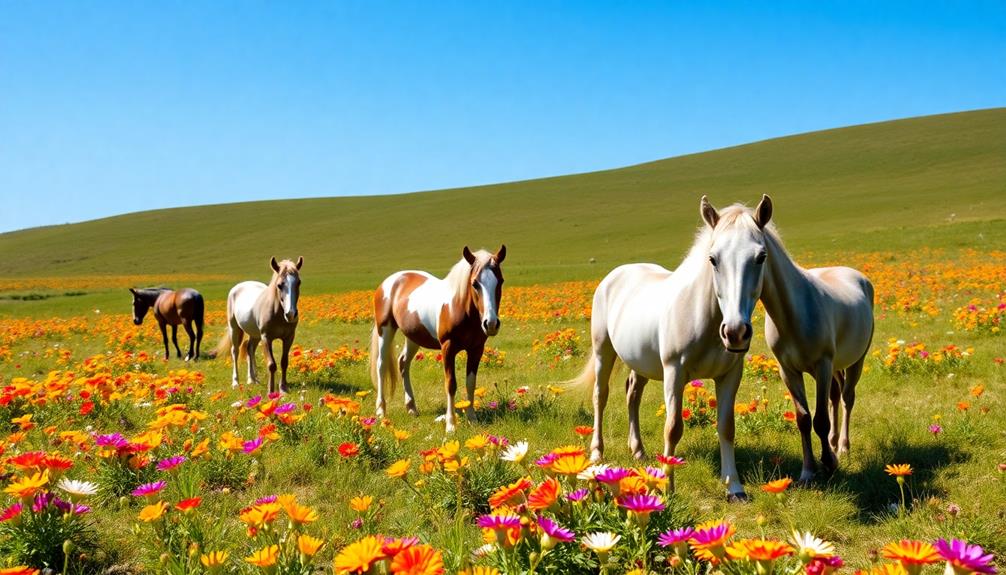
Miniature horses are charming companions, standing 34 inches tall or smaller, which makes them perfect for those who want a compact and affectionate pet. Their friendly demeanor and excellent temperament allow them to thrive in various roles, from therapy animals to beloved family members.
Here are some key characteristics of miniature horses:
- Affectionate Nature: They easily bond with humans and other animals, making them great companion animals.
- Diverse Colors: You'll find unique color patterns and markings, including appaloosas, pintos, and solid colors.
- Gentle Temperament: Their calm and friendly disposition makes them suitable for families, even with young children.
- Responsible Breeding Practices: Breeders focus on enhancing health and temperament, ensuring these horses are well-adjusted and sociable.
- Versatile Uses: They can participate in various activities, including therapy work, showing, and simply being loving pets.
When you consider these characteristics, you'll see why miniature horses are increasingly popular as companion animals. Their manageable size, combined with their delightful personalities, makes them an ideal choice for anyone seeking a loyal and loving friend.
International Buying Considerations

When considering an international purchase of miniature horses, you need to navigate several important factors to secure a smooth transaction. First, confirm that the horses are registered with the American Miniature Horse Association. This guarantees their authenticity and lineage, which is essential for international buyers.
Next, address shipping logistics and quarantine requirements. Many breeders experienced in international sales can assist with these processes, helping you comply with local regulations. Clear communication with the breeder is significant to discuss transportation arrangements and avoid unexpected costs.
Be aware of customs fees and any import regulations that may apply in your home country. Understanding these potential expenses can save you from financial surprises.
Here's a quick reference table to help you visualize the key considerations:
| Factor | Importance |
|---|---|
| Registration | Guarantees authenticity |
| Shipping Logistics | Secures smooth transport |
| Quarantine Requirements | Compliance with local regulations |
Customer Experiences and Testimonials

Many buyers have shared glowing reviews about their experiences with miniature horse breeders, often praising the horses' friendly temperaments and unique personalities.
These endorsements highlight the commitment to quality breeding practices that many breeders uphold, ensuring you get a horse that's not only beautiful but also well-adjusted.
Here are some common themes in customer experiences:
- Exceptional Temperament: Horses that are friendly and easy to handle.
- Long-term Relationships: Many buyers enjoy ongoing mentorship and support from breeders.
- Quality Breeding Practices: Breeders focus on conformation and pedigree, resulting in high-quality minis.
- Community Connection: A welcoming atmosphere fosters camaraderie among miniature horse enthusiasts.
- Guidance for Newbies: Newcomers receive valuable resources, making their entry into the community smoother.
These positive experiences contribute to a strong sense of community among miniature horse lovers, allowing you to feel supported throughout your journey.
If you're considering adding a mini to your life, these endorsements serve as a proof of the rewarding relationships you can build with reputable breeders.
Joining the Miniature Horse Community
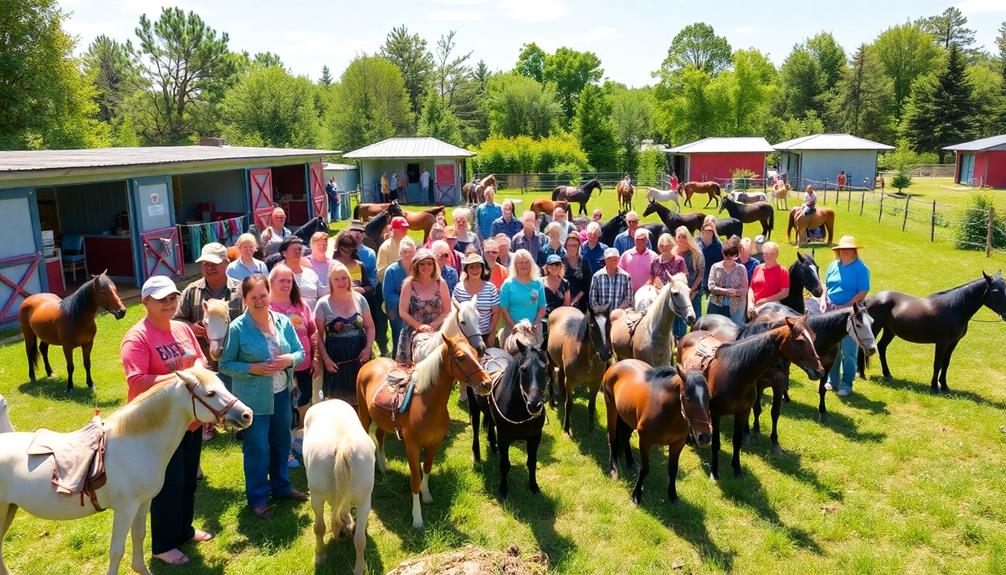
Joining the miniature horse community opens up a world of benefits, from free memberships that connect you with fellow enthusiasts to valuable resources on horse care and breeding.
By engaging in forums and participating in events, you'll build a network that supports your journey as a miniature horse owner.
Embracing this community not only enhances your knowledge but also fosters lasting relationships with others who share your passion.
Benefits of Community Engagement
Frequently engaging with the miniature horse community opens up a treasure trove of shared experiences and valuable knowledge about horse care, breeding, and ownership.
You'll find that being part of this supportive network enriches your journey as a miniature horse enthusiast. Here are some key benefits you can expect:
- Access to Community Forums: Immerse yourself in discussions on care tips, training advice, and best practices to enhance your ownership experience.
- Shared Experiences: Learn from others' successes and challenges, gaining insights that can help you navigate your own path.
- Networking Opportunities: Connect with reputable breeders and fellow enthusiasts, making it easier to find the perfect miniature horse for you.
- Support Network: Get advice and encouragement from like-minded individuals who understand the joys and challenges of miniature horse ownership.
- Local Events: Participate in gatherings that promote awareness of miniature horse breeds and offer hands-on learning experiences.
Networking With Enthusiasts
Building connections within the miniature horse community can greatly enhance your experience as an owner. Joining this vibrant network is easier than you think, especially with free membership options that provide curated content and daily updates straight to your inbox.
Engaging in active forums like the Miniature Horse Forum allows you to share tips and personal experiences while learning from others who share your passion.
Don't underestimate the value of local breeders and community events; they're fantastic for networking and building friendships. When you attend these gatherings, you might even find someone willing to share their favorite cookie recipe!
Membership in community groups fosters opportunities to share success stories and seek advice from experienced owners.
Participating in discussions on important topics such as breeding and care not only helps you gain insights but also strengthens your connections within the community.
Remember, the more you engage, the more you'll learn, and the more rewarding your experience will be. Networking with fellow enthusiasts will provide you with the support and knowledge you need to thrive as a miniature horse owner.
Frequently Asked Questions
How Much Do Dwarf Miniature Horses Cost?
Dwarf miniature horses typically cost between $1,000 and $5,000, depending on age, pedigree, and training. Show-quality horses and breeding stock may exceed $5,000, while additional fees for registration and shipping can add to the total expense.
What Is the Lifespan of a Miniature Horse?
Did you know some miniature horses can live into their 40s? Generally, their lifespan ranges from 25 to 35 years, depending on genetics, care, and nutrition. With proper attention, they thrive for years.
Is There Money in Breeding Miniature Horses?
Yes, there's money in breeding miniature horses. By focusing on show-quality traits, establishing a solid reputation, and targeting niche markets, you can considerably increase your income potential while enjoying the rewarding experience of breeding.
What Is the Difference Between a Mini a and a Mini B Horse?
The difference between Mini A and Mini B horses lies in height. Mini A horses stand 34 inches or shorter, while Mini B horses reach up to 38 inches, offering distinct advantages for companionship or competition.
Conclusion
In the search for your dream miniature horse, remember that the perfect match often comes when you least expect it. Whether you stumble upon a top breeder at a local show or connect with a fellow enthusiast online, every encounter can lead you closer to your ideal companion. Embrace the journey, trust your instincts, and soon you might find that perfect little horse waiting just for you, ready to gallop into your life unexpectedly.
Paul’s love for animals knows no bounds. As a dedicated writer and animal lover, Paul brings a unique perspective to our team. His firsthand experiences with various animals enrich our content and provide valuable insights into their behavior and needs. Whether he’s sharing tips for pet care or shedding light on pressing conservation issues, Paul’s passion for animals shines through in everything he does.
-

 Vetted4 months ago
Vetted4 months ago15 Best Dog Food Brands Recommended by Vets for Healthy and Happy Pups
-

 Vetted4 months ago
Vetted4 months ago15 Best Affordable Dog Foods That Won't Break the Bank
-

 Vetted4 months ago
Vetted4 months ago14 Best Homemade Dog Food Recipes Your Pup Will Love – Vet Approved & Nutritious
-

 Vetted4 months ago
Vetted4 months ago15 Best Cat Foods for Managing Hyperthyroidism – Vet Approved and Feline Friendly
-

 Vetted3 months ago
Vetted3 months ago15 Best Dog Foods for Kidney Disease – Expert Recommendations for Your Pet's Health
-

 Cats3 months ago
Cats3 months agoCat Weight Chart by Age: Kitten to Senior in Lbs
-

 Deers4 months ago
Deers4 months agoCaring for Baby Deer: Tips for Healthy Fawns
-

 Vetted4 months ago
Vetted4 months ago15 Best Vet-Recommended Dry Cat Foods for Indoor Cats – Keep Your Feline Friend Happy and Healthy







































